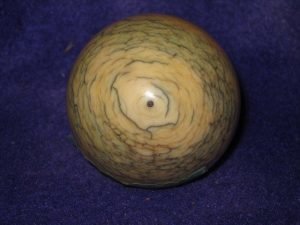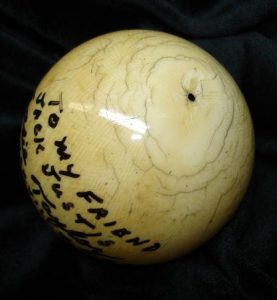How To Tell If Cue Ball Is Ivory
This article is more than 2 years old
The way cue balls have been manufactured have a long history, I have discussed in another post in great detail the transition from ivory to the acrylic cue ball. In present-day time, ivory balls are no longer legally manufactured. They are not as good as the present day acrylic balls and most importantly the ivory trade has pushed elephants to the brink of extinction. This post will help you to know how to tell if a cue ball is ivory or not.
Although good pool balls set can be around $250 but a genuine ivory set can cost as high as $5500. The playing experience with ivory won’t be better than the acrylic balls.
How Certified Ivory Balls Look Like
How To Identify Ivory Cue Balls
There are some ways to determine if the cue ball is ivory or not. Methods include visual inspection or burning of the ball. The third requires testing with blacklight while last is easiest to get an expert opinion.
1. Visual Inspection:
Look at your ivory ball if you see bending spider lines on the ball then it is most likely to be an ivory ball.
Because the ball is old it would turn into a pale yellow color with blue greyish lines on the ball.
The ball due to aging may not be perfectly spherical anymore.
The ball can even turn into dark brown or dark orange depending on the part of the tusk it was made from.
Why Ivory Balls have lines?
Ivory balls have nerve endings that get solidified into the tusk as it grows. Over time these nerve endings show up on the ivory and hence give the ivory its unique identity.
2. Black Light Test:
Make the room dark and then glow the long-wavelength black light on the ball. If the shine on the balls is white or yellowish then it is definitely ivory. If the shine on the ball is bluish then it is most likely plastic/acrylic. The test is straight forward and would double confirm after the visual inspection.
2. Inspect By Heat (LEAST RECOMMENDED)
Another way to identify ivory is by burning it. If it smells like burnt hairs then it is ivory otherwise it may only be ox bones.
The safest way to burn the ivory ball is by heating up a small pinhead and then place the red hot pinhead on the ball. If it smells as if hairs are burning then it is definitely ivory.
Although the first method is good enough but if you are still looking to confirm the ball material then bear in mind that if you chip the ball it will lower down its value.
4. Take To A Pawn Shop
If you have a pawn shop in your vicinity then there is no better way then getting a free quick evaluation of the ball. The experts at pawn shops regularly deal in ivory crafts. The opinion of the expert at the pawnshop can seal the deal and clear the confusion.
How Much Are Ivory Balls Worth
Usually, an ivory ball would sell from a price of $100 to $250. The way the price of the ivory ball is determined depends on a number of factors some of them are these:
Are the balls perfectly round? If yes then this raises up the value of the ivory ball.
Is it hard or soft ivory ball? If it is hard it would be worth more than the softer one. The hardness of ivory balls differs based on the region (north or south) of Africa the elephant belonged to.
Are the balls barky? This would reduce the value of the ball as such balls are made from small tusks that are properly not grown or don’t have the same structural strength than that of a fully grown tusk.
White ivory balls? they can be either soft or hard but are worth more because they are made from the center of the tusk which is the stronger part of the elephant’s tusk.
Matched Set? If you have more than one ivory ball then check their weight on the digital weighing scale if they weigh approximately the same then they were made from the tusk of the same elephant. They will have the same color and are priced quite high as much as $200-$225 per ball.





